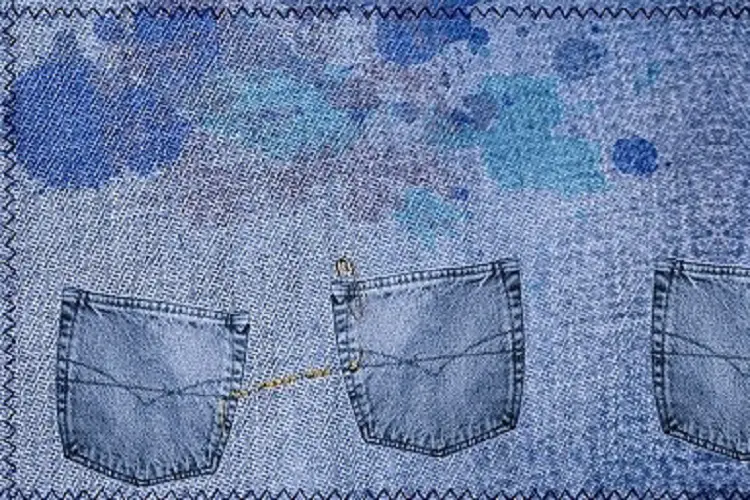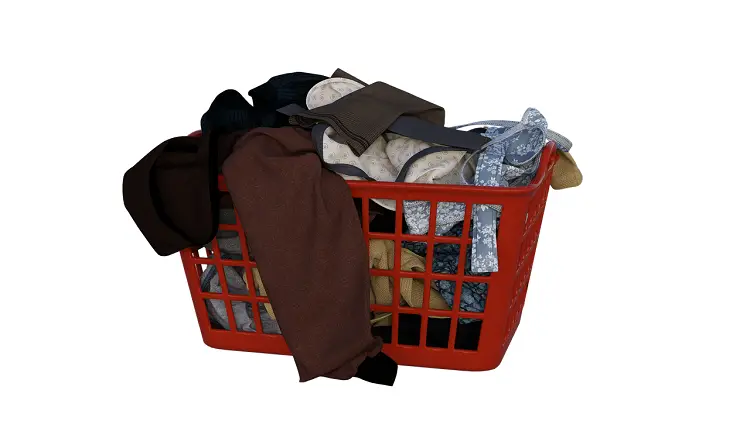Nothing annoys more than putting on a new item of clothing only to spill something on it right after. Even if you do all your laundry right, there’s that particular stain that is too stubborn to disappear.
Rather than discarding your favorite shirt, with a little perseverance and hard work, most stains can be removed from clothes. If the first time fails, don’t give up, give it another go.
In this article, rockydad is here to share a few home tips to try on different set-in stains on baby clothes, pants, and shirts. From ink to blood, learn how to remove set in stains from clothes.
The Complete Guide On How To Remove Set In Stains From Clothes
Adhesives Stains
- Put in ice or cold water to harden surface; scrape with a dull knife.
- Soak with prewash stain remover or cleaning fluid.
- Rinse, and then launder.
Baby Formula Stains
- Soak stains using a laundry product containing enzymes.
- Soak for at least 30 minutes or more for aged stains
- Rinse, and then launder as usual.
Baked Beans Stains
- Dampen it with cold water.
- Presoak the cloth with liquid laundry detergent, using an up-and-down motion with a soft brush to break up the stain.
- Rinse as usual.
- Sponge with white vinegar and rinse again.
- Repeat, treating the stain with liquid detergent, then with white vinegar until the stain disappears.
- Presoak with a prewash stain remover and launder with bleach that’s safe for the fabric.
Barbecue Sauce Stains
- Apply the same method used in treating baked beans.
- However, if the stain refuses to go off after laundering with bleach, rub in liquid laundry detergent and soak in warm water for up to 30 minutes.
- Launder again.
Beverages Stains
- Sponge or soak stain in cool water.
- Presoak with prewash stain remover, liquid laundry detergent, liquid detergent booster, or paste of powder laundry product and water.
- Launder using sodium hypochlorite bleach, if not harmful on the fabric or oxygen bleach.
Remember, older stains may respond to pretreating or soaking in a product containing enzymes, then laundering.
Blood Stains
Fresh Blood Stains
- Soak in cold water.
- Launder as usual.
Remember; do not use hot water as it will set bloodstains.
Dried Blood Stains
- Soak fabric in warm water with a laundry product containing enzymes.
- Launder as usual.
Alternatively
- Treat with hydrogen peroxide or equal parts meat tenderizer and water to the stain and allow sitting for several minutes.
- Rinse the spot clean with water and if the stain remains, apply the hydrogen peroxide or meat tenderizer a second time and allow sitting for a longer time.
Bodily Fluids Stains
- Soak the fabric in a laundry product containing enzymes.
- Launder using sodium hypochlorite bleach, if not harmful to fabric, or oxygen bleach.
Brown / Yellow Discoloration
- Apply a rust remover recommended for fabrics.
- Then Launder as usual.
Remember, not use a sodium hypochlorite bleach to remove rust stains because it may intensify discoloration.
Butter Stains
- Pretreat or soak with a prewash stain remover
- Launder, using hot water.
Read Also: How To Remove Breast Milk Stains?
Candle Wax Stains
- Using a dull knife scrape off the surface of the wax on the fabric.
- Then place the stain between clean paper towels and press with a warm iron. Replace the paper towels occasionally to absorb more wax and to avoid transferring stains.
- On the clean paper towel, place the stain face down. Sponge the remaining stain with laundry stain remover or cleaning fluid, blot with paper towels to dry.
- Launder as usual.
However, if any color remains, rewash using sodium hypochlorite bleach, if safe for fabric, or oxygen bleach.
Chocolate Stains
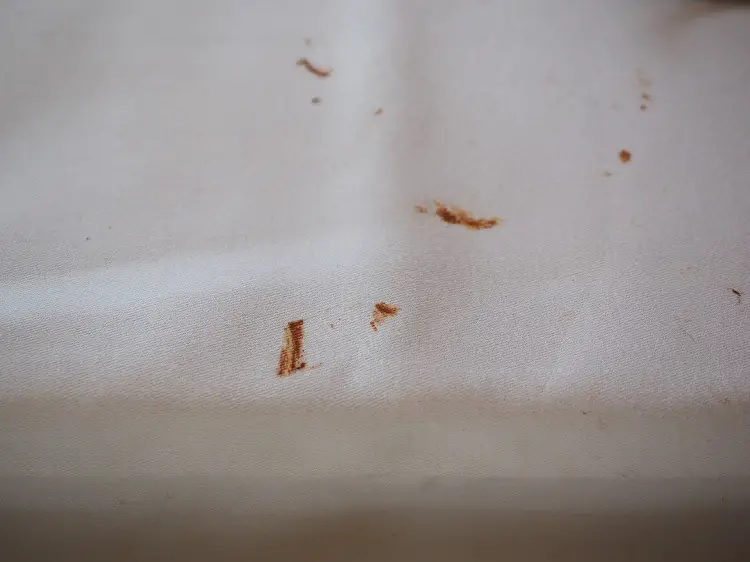
- Gently scrape off excess chocolate on the fabric.
- Soak it in cool water.
- Then soak with a laundry stain remover.
- Launder in hot water that’s suitable for the fabric.
Remember, if stain remains, rewash using bleach safe for fabric.
Collar/Cuff Soil Stains
- Soak the stain with prewash stain remover, liquid laundry detergent, or paste of powder detergent and water.
- Then launder as usual.
Tea/Coffee Stains
- Sponge stain in cool water.
- Then soak with prewash stain remover, liquid laundry detergent, or paste of powder laundry product and water.
- Launder using sodium hypochlorite bleach, if not harmful to fabric, or oxygen bleach. Always remember, older stains may respond to pretreating or soaking in a product containing enzymes, then laundering.
Cosmetics/Lipstick Stains
- Soak fabric with prewash stain remover, liquid laundry detergent, a paste of powder detergent or laundry additive and water. However, you rub with bar soap.
- Launder as usual.
Crayon Stains
For a Few Spots
- Treat the same as candle wax or damp the stain in water and rub with bar soap.
- Launder using hottest water safe for fabric.
For a Whole Load of Clothes
- Wash fabric with hot water using a laundry soap and 1 cup (212 g) baking soda.
Remember, if color persists to disappear, launder using sodium hypochlorite bleach, so far it’s safe for fabric. Otherwise, soak fabric in a product containing enzymes or an oxygen bleach using hottest water safe for fabric, then launder.
Read Also: How To Whiten Baby Clothes Naturally Without Bleach
Dairy Products Stains
- Soak stains using a product containing enzymes.
- Soak fabric for at least 30 minutes or several hours for aged stains.
- Launder as usual.
Deodorants Stains
Light Stains
- Soak fabric with liquid laundry detergent.
- Launder as usual.
Heavy Stains
- Soak fabric with prewash stain remover. Allow standing for 5 to 10 minutes.
- Launder using oxygen bleach.
Dye Transfer Stains
- Try restoring white fabrics that have picked up color from other fabrics by using a packaged color remover, then follow label directions.
- Launder as usual.
Remember, if dye remains, launder again using sodium hypochlorite bleach, if not harmful to the fabric. Also, for non-colorfast fabrics, soak in oxygen bleach, then launder.
Alternatively, here is video showing you how to remove hair dye stains from clothes
Egg Stains
- Soak stains using a product containing enzymes.
- Soak fabric for at least 30 minutes or several hours for aged stains.
- Launder as usual.
Fabric Softener Stains
- Dampen the stain and then rub with a bar of mild detergent soap.
- Rinse out, and then launder.
Fruit Juices Stains
- Wash with bleach safe for fabric.
Grass Stains
- Soak fabric in a product containing enzymes.
Remember, if stain persists, launder using sodium hypochlorite or oxygen bleach, if the bleach is safe for fabric.
Alternatively
- Fill a washbasin and prewash the stained portion of the fabric in undiluted white vinegar for 30 minutes.
- Then launder
- If the stain refuses to go after washing, do not dry it. Treat it again.
Grease And Oil Stains
Light Stains
- Pretreat fabric with prewash stain remover, liquid laundry detergent or liquid detergent booster.
- Launder as usual using hot water safe for fabric.
Heavy Stains
- Place stain on fabric face down on clean paper towels. Apply laundry fluid to the back of the stain.
- Replace paper towels under stain frequently.
- Let dry, rinse. Launder using hot water safe for fabric.
Alternatively
- Mix 1 tablespoon of both glycerin and dish soap to 1.5 cups of warm water.
- Shake up the mixture.
- Now spray the stain on the fabric. Ensure to soak the entire area.
- Let it sit on the stain for about 15-20 minutes.
- Wash the fabric in cold water and add a tablespoon of baking soda to the load. This helps to soak up any remaining grease.
- Hang to dry.
Iron Scorch Marks Stains
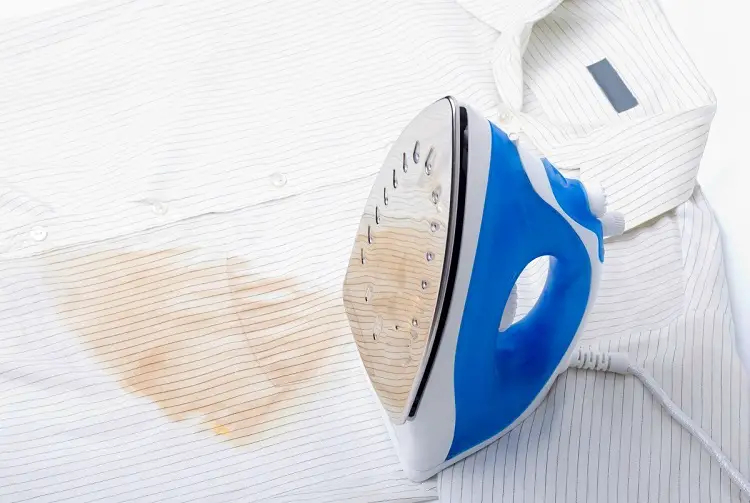
- To wipe away the damage, launder using sodium hypochlorite bleach, if safe for fabric. Also, you can soak in oxygen bleach and hot water, and then launder.
Alternative Method
- Try soaking a cotton ball or rag in vinegar and dabbing at the scorched area.
- Blot the stain with a clean rag to wipe the stain.
Remember, it may take more than one application to remove the scorch mark fully. However, some badly scorched fabrics may be damaged beyond repair.
Ice Cream Stains
- Soak stains on the fabric using a product containing enzymes.
- Soak for at least 30 minutes if the stains are old.
- Launder, using warm water.
Ink Stains
- Sponge the area around the stain on the fabric with rubbing alcohol or cleaning fluid before applying it directly to the stain.
- Place the stain face down on a clean paper towel or rag. Apply alcohol or cleaning fluid to the back of the stain. Remember to replace paper towels frequently.
- Rinse and launder.
Alternate Method
- Position the stain over the mouth of a jar or glass; hold the fabric tight.
- Drip the alcohol or cleaning fluid through the stain so the ink will drop into the container as it is being removed.
- Then rinse and launder.
However, some inks like a ballpoint, felt tip, liquid- may be impossible to remove.
Ketchup Stains
- Take away any excess ketchup with a spoon or knife, but be careful not to rub it into the fabric more.
- If the cloth is washable, remove the cloth as soon as possible and run cold water through the stain from the backside to force the stain out of the clothing.
Remember; avoid dabbing at it to avoid the stain spreading.
Lipstick Stains
- To take out most lipstick stains from napkins, put the napkin stain down on top of a couple of layers of paper towel or absorbent towel.
- Then dampen another towel with rubbing alcohol (70 or 90 percent), then dab the stained area severally.
- Look underneath and you should see lipstick on the paper towels. Keep at it until all of the stains in the fabric is gone. Although, some long-lasting lipsticks may need extra work to go off.
Maple Syrup Stains
- To remove maple syrup or corn syrup, use a blunt kitchen knife to take out any excess syrup still on the fabric.
- For washable fabrics, rinse with cool to warm water from the back of the stain.
- Soak with a stain remover or liquid laundry detergent and let sit for several minutes and then rinse.
- Wash as directed according to the garment label.
- Don’t put in the dryer until the stain is removed.
Mayonnaise Stains
- Soak with a prewash stain remover.
- Launder, using hot water.
Mildew Stains
- Launder stained items using bleach that is safe for the fabric along with hot water. Remember, badly mildewed fabrics may be damaged beyond repair.
Mud Stains
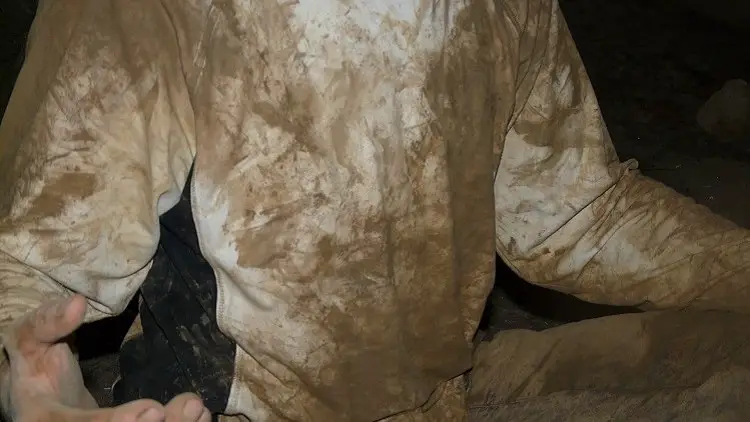
- Brush off as much mud as possible when dry.
For Light Stains
- Soak or pretreat with a paste of powder detergent and water, liquid laundry detergent or a liquid detergent booster.
- Then launder as usual.
For Heavy Stains
- Soak with laundry detergent or a product containing enzymes.
- Then launder as usual.
Mustard Stains
- Soak the fabric under cold water to loosen the stain, and then pretreat with a prewash stain remover.
- Launder, using hot water. Also, add chlorine bleach to the wash. Always check the care label to see if it is safe for the fabric.
Nail Polish Stains
- Try using nail polish remover but do not use on acetate or triacetate fabrics.
- Place stain face down on clean paper towels, then apply nail polish remover to take out the stain. Replace paper towels frequently.
- Repeat the process until the stain disappears.
- Once the stain is wiped rinse and launder as usual.
Remember, sometimes nail polish may be impossible to remove.
Paint Stains
For Water-based Paint
- Soak the fabric in warm water while stains are still wet.
- Then launder as usual.
However, bear in mind that once the paint is dry, it cannot be removed.
For Oil-based Paint and Varnish
- For oil-based paint, use the same solvent the label on the can advises for a thinner.
- If not available, use turpentine.
- Then rinse.
- Soak with prewash stain remover, bar soap, or laundry detergent.
- Rinse and launder as usual.
Perfume Stains
- Soak with prewash stain remover or liquid laundry detergent.
- Launder as usual.
Perspiration Stains
- Use a prewash stain remover or rub with laundry soap.
- Then launder using hot water.
Bear in mind that, if perspiration has changed the color of the fabric, you should apply ammonia to any fresh stains or white vinegar to old stains; then rinse.
Remember, stubborn stains may respond to washing in a product containing enzymes or oxygen bleach in the hottest water safe for fabric.
Read Also: Why Do Pillow Turn Yellow?
Pine Resin Stains
- Sponge the stained area on the fabric with a dry-cleaning solvent; leave it to air-dry.
- Soak the stain in a solution of one cup of liquid laundry detergent and a few drops of ammonia for at least 30 minutes. Remember, do not mix chlorine bleach and ammonia the resulting fumes are hazardous.
- Launder as usual using a liquid laundry detergent.
Rust Stains
- Soak a cotton ball in vinegar and use it to soak up the stain.
- Use a thin layer of salt and cover the stain, and then rub it into the vinegar and the fabric.
- Then lay the garment outside in direct sunlight until the stain has faded, then wash as usual.
Scorch Stains
- Launder fabric using sodium hypochlorite bleach, if safe for fabric.
- Alternatively, soak fabric in oxygen bleach and hot water, and then launder.
Remember some scorched fabrics may be damaged beyond repair.
Shoe Polish Stains
Liquid Shoe Polish
- Soak with a paste of powder detergent and water.
- Launder as usual.
Paste Shoe Polish
- Take off the residue from fabric with a dull knife.
- Soak with a prewash stain remover or cleaning fluid then rinse.
- Then rub detergent into the dampened area.
- Finally, launder using bleach safe for fabric.
Soft Drink Stains
- Soak fabric in cool water for about 30 minutes and then sponge the stain.
- Then pretreat fabric with a laundry stain remover.
- Add chlorine bleach if safe to the fabric then launder.
Tar Stains
- Use a dull knife to scrape off residue from fabric.
- Place stain face down on paper towels then sponge with cleaning fluid.
- Remember to replace the paper towels frequently to absorb more tar and to avoid transferring stains.
- Launder in hot water.
Tobacco Stains
- Dampen stain and rub with laundry soap.
- Then soak in a product containing enzymes.
- Launder as usual.
However, if stain refuses to go away, launder again using a bleach that is safe for fabric.
Tomato Stain
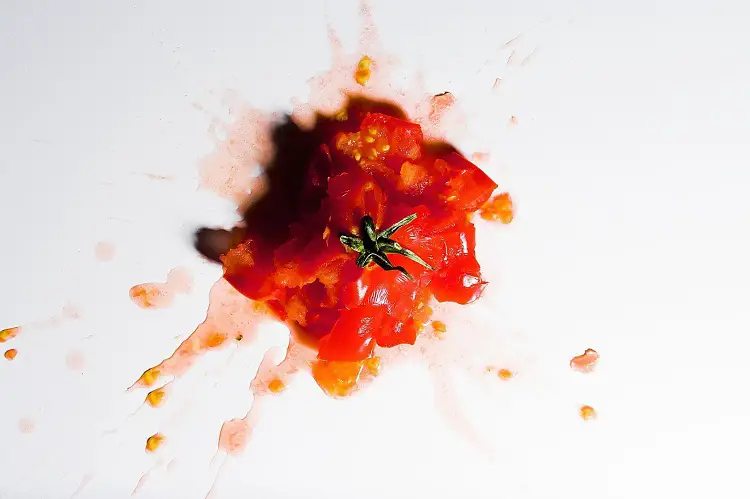
- Absorb the tomato stain with enough vinegar and allow it to soak in.
- Then, launder as usual.
Always make sure the stain is out before you run the fabric through the dryer.
Typewriter Correction Fluid Stains
- Allow the stain to dry thoroughly, then gently brush excess stains off with a clothes brush.
- Then send it to a professional dry cleaner and mention the type of stain.
Vomit Stains
- Rinse the fabric in cool water to remove as much vomit as possible.
- Dampen the stain in vinegar and wash the garment.
- Repeat this process, if necessary till the stain disappears.
Watermelon Stains
These set of stains fall into the category of “invisible stains”. The drips dry up and the stain seems to disappear but after some time, the stain oxidizes into pale yellow or brown stains. To keep this from happening:
- Launder the fabric in the hottest water which is safe for the fabric.
Wine Stains
- Soak fabric in cool water for about 30 minutes and then sponge the stain.
- Pretreat with a laundry stain remover.
- Add chlorine bleach if safe, then wash launder.
Wood Stain
Water-Based Wood Stain
- Firstly, lay down a thick layer of white paper towels then place the stained fabric on top of the paper towels, with the stain face down on the paper towels.
- Then you pour a cupful of acetone onto the stain and dip a neat, white rag into the acetone.
- Then blot the stain with the acetone-soaked rag and press the stain into the paper towels.
- Now move the stained fabric around the surface of the paper towels to wipe areas after each blotting.
- Rub the stain starting at the outer edges and working your way toward the center.
- Continue to blot and rub the fabric until the stain disappears.
- Then rinse and launder as usual.
Oil-Based Wood Stain
- Firstly, place a thick layer of white paper towels on a work surface. Lay the stained clothing or fabric facing down on the paper towels.
- Now dip a neat, white rag into mineral spirits.
- Then blot the stain, beginning at the outer edge of the stain.
- After you’ve done that, push the stain into the paper towels to transfer the wood stain from the fabric onto the paper towels.
- Move the stained fabric around on the paper towel surfaces.
- Continue to dip the rag into mineral spirits and blot the stain until it goes off.
- Then rinse and launder as usual.
If you have any questions or know any other tips on how to remove set in stains from clothes, kindly share with us in the comment section below.
